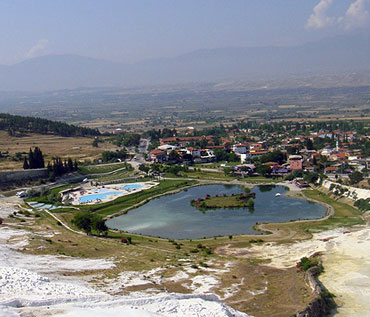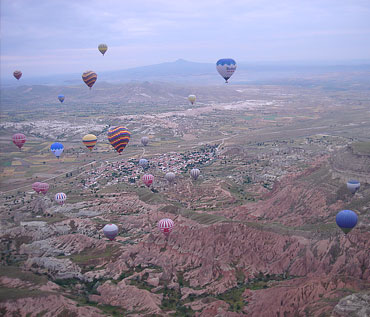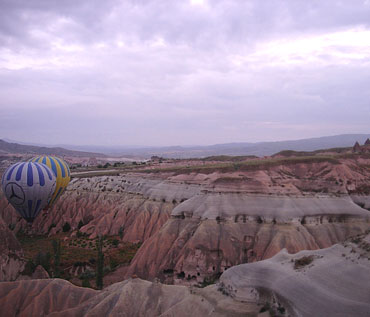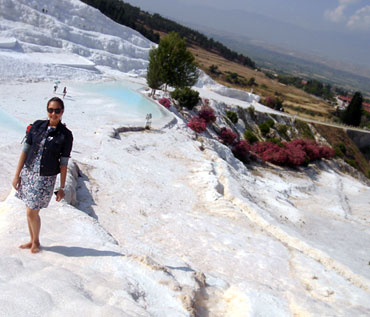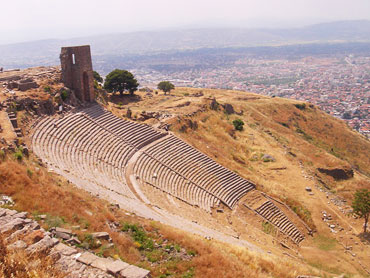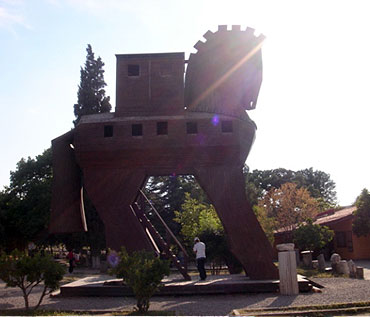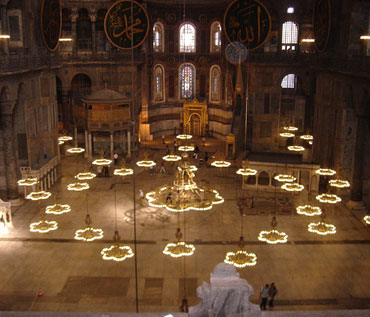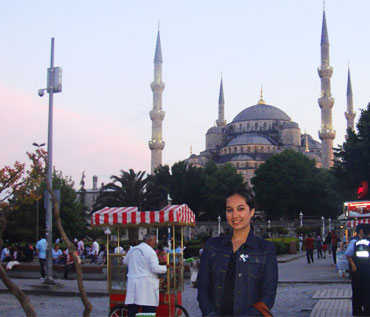 | « Back to article | Print this article |
Travel: The magic of magnificent Turkey
Get Ahead reader Sabiha Ghiasi shares her fascinating trip to Turkey, the Gateway between Europe and Asia.
After much indecision and debate about the most ideal spring-summer vacation spot not very far from home, Mom and I finally hopped on to a Turkey-bound flight in the middle of June.
We pulled up our socks and fastened our shoelaces for the next action-packed and simply fascinating eight days in the 'Gateway to Europe and the Backdoor to Asia.'
June 11
We arrived at Istanbul -- which is on the bustling European side of the country -- and were warmly received by our guide for the trip, Naci (pronounced 'Naji' or 'Nachi'). No sooner than we had freshened up and could feel our feet again, we hopped aboard a cruise on the beautiful Bosphorus.
The cruise was a sensory explosion of sorts, with the cold wind lashing against our eager faces, while the warm mid-afternoon sun bathed the deck in its dazzling golden hues. As Naci helpfully pointed out, the beautiful, opulent architecture that lined the side closest to us belonged to the European side of Turkey.
Istanbul's grandiose past merged fluidly with its bustling present, as palaces and fortresses jostled cheek-by-jowl with swanky nightclubs and restaurants on the angler-dotted promenade. Naci then identified for us the visibly greener and spacious Asian side of the country, as the boat swung towards the shore.
All through the cruise, we sipped on refreshing apple tea (or Cay, pronounced 'Chai') as our enthusiastic guide shared exciting titbits about the two Bosphorus bridges and the various palaces in the city, and also his views about tourism in Turkey.
Later, we headed to Sulthanahmet Street -- one of the quaintest shopping and dining areas of Istanbul and any bus-drive's nightmare for an early dinner. Our day drew to a close at the hotel, where we were dropped off just in time for the 9 pm sunset.
Want to share your travel story with us and others around the world? Simply write in to getahead@rediff.co.in (subject line: 'My Travel Story'), along with pictures of the destination you're writing about. We'll publish the best ones right here on rediff.com!
A hot air balloon ride
June 12
Day Two saw us at the airport again -- this time, for our flight to the city of Ankara. We were welcomed by the coy Yousef and his spacious bus, both of whom made our cross-country trip such a pleasure.
After a typical Turkish meal -- complete with aubergine and baklava -- we ventured into the Mausoleum of Ataturk. Considered the founder of modern Turkey, Ataturk graces every Turkish Lira, his expression growing increasingly graver in direct proportion to the denomination of the note. While a smiling Ataturk graces a 5 TL note, his expression is stoic and impassive on a 100 TL bill.
The mausoleum is home to everything that once belonged to him -- from his tie-pin to his trench coat. From paintings, armour and cultural relics to nuggets of history about his work towards the establishment of the Republic of Turkey, the mausoleum is a complete eye-opener about the life and times of this ancient ruler.
After a leisurely tour of the edifice and sauntering down the rose bush-lined avenue, we went on to explore the breathtaking views of Ankara, armed with our frenzied cameras.
Next on the itinerary was a visit to the Ancient Civilisations Museum, which showcases a vast collection of remains from the Neolithic village that date back to the BCs.
Pots and pans, jewellery and even houses that had doorways on the roof -- we took all of ancient Turkey in with wide-eyed wonder.
Our journey to Cappadocia (or Kapadokya) later that evening -- which would undoubtedly be the highlight of the trip -- was against the beautiful backdrop of the clear skies melting into the liquid orange hues of the setting sun.
June 13
The three cities of Kayseri, Nigde and Nevsehir, which form an earthy Summer Triangle on the map of Turkey, are collectively referred to as Cappadocia. Most of this region falls in the province of Nevsehir and is one of Turkey's hottest tourist spots.
I crawled out of bed at 4:30 in the morning for the trip to Uchisar in Nevsehir. Having lived all my life in the confines of a concrete jungle, this was my long-wished opportunity to live out my adventurous streak to its fullest -- I was going on a hot air balloon ride.
Looking down at Mount Erciyes
I buttoned up my jacket and put on my mittens, which would shield me from the 11-degree wind, and then clambered into the balloon basket. The man of the hour was Tahir, our pilot.
Before we realised it, we were up in the air, looking down at Mount Erciyes and its mystical volcanic rock formations in their full glory.
While the word 'breathtaking' would (or could) not do full justice to the view from approximately 700 m off the ground, it did come a pretty close second. After Tahir had scrambled for landing, giving us an extra half hour to take in the view and shiver in the cold, we were dropped off at the hotel.
The touristy part of our day began with a visit to the Kaymakli Underground City. This city was once one of the largest underground settlements in Cappadocia, was used as a sanctuary by early Christians from invasions by armies, and was completely self-contained.
While the city spirals underground for close to eight storeys, only the first five storeys are open to visitors today. Be warned however, for this expedition is not advisable for the claustrophobic.
We then stopped by at the region's natural citadel before lunching at the mystical Pigeon Valley. Later, we headed to Goreme -- famous for its hoodoo or fairy chimney formations and its Open Air Museum.
The Goreme Open Air Museum is awe-inspiring with its frescoes, murals and large number of Christian artistic representations. There are also a few caves that are located on the cliffs of this World Heritage site that preserve paintings and artwork from the Byzantine period.
Naci then whisked us off to see the making of the famous Turkish carpets and mosaic ceramics. After a packed but fun-filled day, we were offered the opportunity to enjoy the spoils of a Turkish night out. Needless to say, we gulped down our dinner and eagerly piled into the car that would drive us to Urugup for the Turkish dance show.
In the 'cave lounge', we ended the day grooving to typical Turkish music, folk dance and the event of the night -- Turkish belly dancing!
Pamukkale, the cotton castle
June 14
We checked out early the next morning and headed towards Konya. En route, we stopped in Sultanhani, at what was once the largest caravanserai in Turkey. Located a few kilometres from Aksaray, this way station was a common stop during long journeys on the Silk Road.
Once in Konya, we headed straight to the Mausoleum of Mevlana Jalaluddin Rumi. The compounds of the mausoleum are garnished with hundreds of rose bushes -- a soothing, welcoming sight.
The mausoleum houses various relics that are of immense cultural and spiritual significance to followers of this poet and Sufi guru. The Masnavi, a six-part book of poetry by the literary scholar, can be found here, along with several other works by him.
After our enriching tour of the place, we were escorted to a Whirling Dervishes performance. Rumi was the founder of the Mevlevi Order that is famous for this Sufi dance.
Watching the dervishes sing a prayer and whirl to the almost melancholic music is definitely a spiritual and surreal experience. Wrapping the day up, we hopped on to the bus and began our journey towards Pamukkale -- the cotton castle.
June 15
Pamukkale is located in the city of Denizli and is famous for its travertine formations. Indians, on the other hand, are famous in the region because of a recent Hindi movie song that was shot at its travertine pools.
This region is adorned with water terraces and we were given free time to dip our feet in the calcium carbonate-rich water, while we basked in the warmth of the Turkish summer sun.
This was by far the most crowed place we visited during the trip -- overflowing with Europeans and natives alike. Our little jaunt ended much too soon for us, however, as we were scheduled to visit the ancient city of Hierapolis.
Bergama Amphitheatre
The hot springs of Hierapolis have been a hotspot for centuries, on account of their healing properties. We strolled through the remains of this ancient city as Naci narrated its long, complicated history.
The star attractions of Hierapolis are the large necropolis (meaning 'City of the Dead' in Greek), the 15,000-plus seater theatre, the famous Temple of Apollo and the intriguing pool of Cleopatra.
Our second lesson in Greek-Roman history was at Ephesus -- famous for the Library of Celsus and what little remains of the Temple of Artemis, one of the seven wonders of the ancient world.
Our last stop for the day was the coast of Kusadasi (meaning the Island of Birds) near the Selcuk region, which is dotted with various cruises and yachts that light up the coast after sunset.
June 16
The next morning we made our way to Bergama (or Pergamon) via a cable car. Like other Roman-Greek ancient cities, this site has a culturally and scientifically significant history. The city is like a maze, and can be entered and exited from various locations.
Naci chose the easiest route for us, but climbing up the ancient stone steps was nothing short of an ambitious cardio workout. We saw the huge amphitheatre, and walked through the beautiful stone arcades towards the old library that once held hundreds of thousands of parchments.
History and literature buffs will be pleased to know that Bergama is also the birthplace of parchment!
The legendary city of Troia
Post lunch, we drove past the oxygen-rich Ida Mountains (Kaz Dagi, on the map) towards the legendary city of Troia (or Troy). We learned how this city was built and destroyed nine times, and all about its almost-filmi history in Homer's epic poem, Illiad.
For more information about the Trojan war and Troy, Naci said, Brad Pitt's Troy could be a quick review. The Trojan horse replica near the site's entrance was a willing model for our greedy cameras, which quickly snapped up souvenirs of what is one of history's most tragic coups.
The wooden horse that was created for the Hollywood blockbuster based on this city was gifted to the region and stands tall in the main market square today.
Leaving Troy, we made our way to the city of Canakkale, where we spent the night. The hotel had an attached beach and a pier, which afforded us gorgeous views.
We watched the sun set over the city from the end of the pier, our feet relishing the soft lapping of the salty waves, and happy smiles plastered on our tired faces.
June 17
We left Central Anatolia in the morning and made our way back to Istanbul. To cut the drive short, we were ferried across the Dardanelles Strait -- bus and Yousef in tow.
A long drive and a quick meal later, we headed towards the Topkapi Palace. Istanbul was much warmer than where we had come from, as was evident from the sunglasses that were hurriedly pulled on.
As soon as we entered the gates of the palace, we heard loud drumming and singing. Naci told us that we were indeed lucky, because the band that was about to perform that day was supposedly the oldest war band in the world!
We then spent a good hour exploring the large palace, which is tiled with colourful mosaic and frescoes at a few places. We also saw jewellery and armour from the time of Prophet Mohammed, and other artefacts that are of religious significance to Islam.
Hagia Sophia
Leaving the palace, we headed to the misleadingly-named Hagia Sophia or Saint Sophia (no, it isn't the name of a saint, but actually means Holy Wisdom).
Legend has it that this magnificent cathedral-turned-mosque-turned-museum was the blueprint for very many consequent constructions in Turkey for over hundreds of years.
The most famous attempted replica of this is the Sulthan Ahmed or Blue Mosque located exactly opposite it. We entered the structure in the evening, when it was completely lit up.
Words definitely cannot describe the beauty and opulence that the structure exudes. The gates of the lower floor made my 5' 9'' frame feel nondescript in comparison, while the various chandeliers complete with little bulb-holders were mesmerising.
We then made our way to the upper gallery via the spiralling ramp that was built for the easy transportation of the raw materials during Saint Sophia's construction. Although only three storeys high, the climb felt never-ending; the view to the lower deck from here, however, effortlessly silenced our complaining feet.
The walls are adorned with various mosaics and large, round boards that feature the names of the five prophets of Islam, giving the structure an ancient, steeped-in-history atmosphere. As hour later, we crossed the street to set foot in the famed Blue Mosque.
The Blue Mosque
The Sultan Ahmed Mosque is commonly known as the Blue Mosque because of the blue mosaic work that completes its interiors. Tourists are welcomed with scarves to cover their head and wrap-clothes to drape around their shorts.
The mosque is its busiest best on a Friday and is the prayer centre of Istanbul. After a few minutes inside the mosque, we moved to the ground adjacent to it -- The Roman Hippodrome.
This horse chariot racing place is the widest Hippodrome in the world, and was once a circus. It is also home to one of the three Obelisks in the world along with what remains of the Serpent Column.
Hungry, fatigued and enlightened with our crash course in ancient Roman-Greek history, we had our last dinner in Turkey.
June 18
Since we had spent the last few days strictly sightseeing, with no time to shop for anything larger or more significant than fridge magnets, we pleaded with Naci to let us spend our last few hours in the country shopping.
We checked out of the hotel after a comfortable breakfast and were taken to the famous Spice Market of Istanbul. This L-shaped market is full of jewellery, antiques, ceramics and of course, spice stores.
Coming from the land of spices, we ignored the spice vendors and headed straight for the metal jewellery and the mosaic tiles. Naci cautioned us to save some money for later since we were then heading to the Grand Bazaar, which, as the name suggests, is the mother of all street-shopping places.
The Grand Bazaar has approximately 4,000 shops sprawled across almost 60 lanes. Everything from fake fur and Bottega Venetas to ostentatious diamonds and rubies can be bought at this market.
It has various little jewellery and antiques shops where inspired shoppers can eke out a good bargain. Like the Indian shopping system, it is very important to ask for discounts at small shops in Istanbul.
After we had found track of time again and boarded the bus, we bade goodbye to the city and set out for Ataturk International Airport, where a Mumbai-bound flight was waiting to carry us home.
The trip would not have been the same without Naci's prolific knowledge about his country, his exemplary insights of its history and his exceptional belly dancing skills (you read that right!), Yousef's patience with us and how he only flinched each time he saw us carry food into the bus that he would have to clean, and our wonderful travel mates from various parts of India.
I hope this diary entry helps you to relive one of the most memorable holidays I have ever had.
